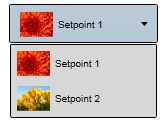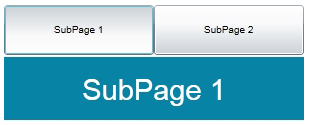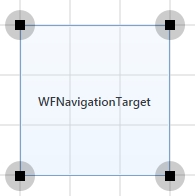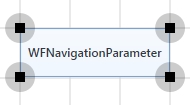Navigation
Check out this article and learn more details about the WEbfactory 2010 SmartEditor Navigation controls.
Without the ability to navigate to different pages using the browser's buttons in Silverlight, creating big scale visualizations is only possible using the functionality provided by the Ewon by HMS Networks controls library. The Navigation category contains controls that provide an effective solution for creating complex navigation in Silverlight applications.
The eight controls from the Navigation category are available in SmartEditor, Blend and Visual Studio. Navigation controls provide core navigation functionality as well as extended features like opening web pages or pop-up windows.
Click on controls names from the table below to view their particular properties:
Name | Description | Screenshot |
|---|---|---|
WFNavigation offers the basic functionality of opening a specified navigation page inside a frame (WFNavigationTarget), with the addition of the enhanced Ewon by HMS Networks properties like Security and Parameter passing. |  | |
WFLinkButton1 offers the basic functionality of a hyperlink button, with the addition of the enhanced Ewon by HMS Networks properties like Security and Templating. |  | |
WFOpenDialog is a Windows-styled button that allows the user to open a template page when clicked on at run time. Besides opening a modal or modeless template page, the WFOpenDialog button can also pass parameters to the controls contained by the opened template page. Also, the Ewon by HMS Networks security and translations features are available. |  | |
WFNavigationComboBox1 allows the user to select the navigation page to be displayed in the navigation frame using a combo-box menu. It also supports visual customization and multiple visual states driven by the value of a signal. In addition, all the Ewon by HMS Networks specific properties like Advanced Security and Translations are available. |  | |
WFNavigationToggle1 offers a functionality similar to the WFNavigation button, but in addition to the normal button functionality, it has two different operational states: unchecked and checked. The WFNavigationToggle1 button is designed to work as a tab button, indicating the selected tab, and thus, the opened SubPage. |  | |
The WFNavigationTarget control is the frame in which the navigation pages (or SubPages) are displayed. The WFNavigationTarget control is the parent of one or more navigation pages. A navigation page can be added only if the WFNavigationTarget control is placed on the page and selected. By default, the navigation page will have the same size as the WFNavigationTarget control. |  | |
The WFNavigationParameter control is the crucial part in passing parameters from a navigation button to the content of the navigation SubPage. The WFNavigationParameter control resolves the parameters sent by the navigation buttons and makes them accessible to the controls configured to use them from the navigation page. The WFNavigationParameter control can also be used to define a different set of parameters, using it's own Parameters editor. The parameters defined in the WFNavigationParameter control are available to all the controls on the same page and to the controls contained by the pages opened from the page containing the WFNavigationParameter control. The WFNavigationParameter control does not have any UI-related role and should not be visible at run time. |  | |
WFHtmlHost control allows the user to display a web page within an frame inside the Silverlight visualization. The web page address is set at design time using the WFHtmlHost control's properties. At run time, the web page will be displayed automatically in the control. |  |